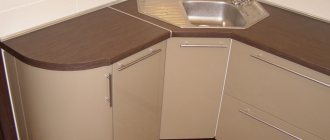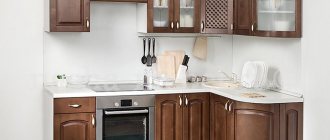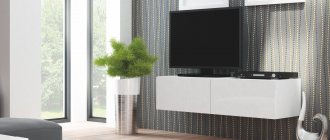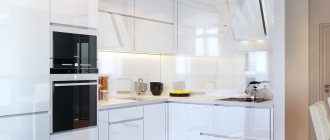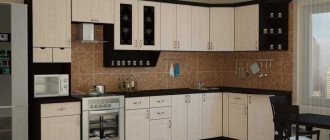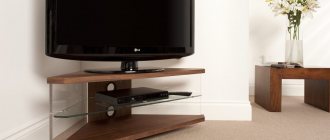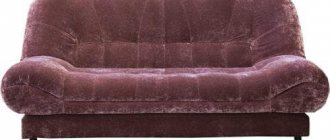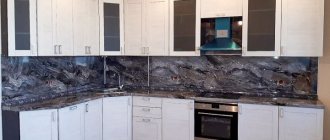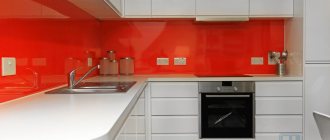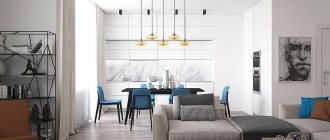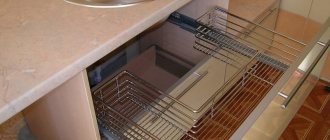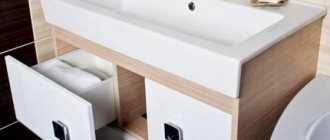Working triangle rule
In the kitchen, all cabinets and household appliances should be located so that little effort and time is spent when preparing food. Therefore, in this room you should definitely apply the rule of the working triangle - place functional zones on its tops within 1-2 m from each other.
The main zone accents in the kitchen are:
- refrigerator, food cabinets;
- sink, table;
- hob, oven.
Triangular arrangement of furniture in the kitchen is possible according to the following schemes:
- In one line. The cooking area is located between the refrigerator and appliances.
- In two rows. On one side of the kitchen there is a working and storage area, on the other there is a dining area.
- Island. In the allocated space there is either a stove/oven or a sink; all other furniture occupies the space along the walls.
- Peninsula. There is a separate table or bar counter with equipment for processing or preparing food.
- L-shaped layout. The refrigerator is installed in one corner, and the hob and oven with sink are in the other.
How to use a corner cabinet
Inside the corner cabinet in the kitchen you can place:
- A trash can is a necessary item in the kitchen. Hidden behind the doors of the base cabinet, it will not attract the attention of guests. Today, it is popular to use containers that allow you to sort waste: paper, glass, organics.
- Part of kitchen appliances, for example, water filter, food waste disposer.
- Boiler. We are talking about a flow model. Only a compact heating device will fit under the sink.
- Kitchen utensils, cleaning products, pet food, etc.
The corner cabinet under the sink can be equipped with two shelves for storing household chemicals
To increase the capacity of a corner cabinet in the kitchen, you should install in it:
- A pull-out basket that holds many items and rolls out gently when the handle is pulled;
- Carousel shelves that make it easy to reach all the items placed on them;
- Ordinary wooden shelves that should be installed on the side walls of the cabinet;
- The boxes are of an unusual shape, with a cut-out center through which a sewer pipe passes.
Storage system in the kitchen in the corner cabinet under the sink
Corner sink for the kitchen: varieties based on material of manufacture
Corner sinks used for washing dishes are made from different materials. Each of them has its own technical characteristics and, accordingly, pros and cons. The following materials are most often used to make sinks:
- stainless steel;
- ceramics;
- stone (artificial and natural).
Stainless steel. Products made from this material are the most common. This is due to the fact that they are affordable. Corner kitchen sinks made of stainless steel can have a matte texture or a glossy surface. Products of the second type are easier to maintain, which is why many experts recommend purchasing them.
Another advantage of stainless steel sinks is their versatility. They have a simple design and can be combined with any type of kitchen interior. Stainless steel is resistant to corrosion. Among the disadvantages of such sinks, it is worth noting their noise. Corner kitchen sinks made of stainless steel are also easy to install, so installing them yourself will not be difficult.
Metal sinks look especially good in classic and traditional kitchen interiors.
Ceramics. Sinks of this type are distinguished by a presentable appearance. Most often, classic white ceramic products are found, but there are also colored models. The main advantage of such sinks is their resistance to moisture and active chemicals used for washing dishes. The disadvantage of such products is their large mass, which complicates transportation and installation. It is also worth noting that chips may occur on the ceramic surface over time.
Artificial and natural stone. Such models belong to the upper price category. The advantages of these sinks are their elegant appearance and long service life. Corner sinks for kitchens made of artificial stone are resistant to aggressive chemicals and high temperatures. The variety of options for products made from this material is very wide.
Natural stone is more expensive than artificial stone, but is considered a more reliable material. Sinks of this type absorb the noise of water flowing from the tap, which is also a big plus.
Today, kitchen sinks are made from various materials with good quality characteristics.
Requirements for corner sink models
The choice of plumbing fixtures is most often made taking into account the individual characteristics of the kitchen space and the personal taste preferences of the owners
However, there are still several important points that you should pay attention to before purchasing a sink.
Before purchasing a corner kitchen sink, you need to calculate its volume. This indicator is selected depending on the personal needs of the kitchen owners. It is necessary that the sink accommodate a certain amount of dishes used during meals for all family members.
Bowls must have good resistance to high temperatures. Otherwise, the service life of the plumbing equipment is reduced several times.
It is also very important that the sink is resistant to mechanical stress (impacts)
Experts advise taking the selection of furniture for a corner sink seriously. Kitchen sink cabinets may vary in size, material and design.
The universal size of bowls for any sinks, including corner ones, is a depth of 16-20 cm
Not only corner models, but also any other sink options must have good resistance to aggressive chemical compounds contained in detergents.
And finally, before purchasing this plumbing fixture, you need to determine in advance the place where it will be located and take the appropriate measurements. Kitchen designs with corner sinks can be studied on the Internet. This will allow you to select the required product.
There are two ways to install this type of kitchen sink – with the help of specialists or on your own. In the second case, it is recommended to study the installation instructions and strictly adhere to the sequence of actions that are described in it.
The guidelines for action when choosing sinks should be the dimensions of the kitchen furniture
Typical sizes
The dimensions of the kitchen sink cabinet depend on many factors:
- The width of the product is calculated taking into account the internal contents - the more shelves and additional compartments there are, the wider the cabinet should be.
- The height must correspond to the parameters of the adjacent parts of the headset; the cabinet cannot be higher or lower than them.
- The length can match the parameters of the sink or exceed them.
The dimensions of corner models directly depend on the presence of other pieces of furniture nearby.
Standard parameters for straight square structures: 90 x 90 cm, the length and width of rectangular products with one door can be 55 x 45 cm, and two-door structures - 100 x 45 cm. The sides of trapezoidal models of corner sets adjacent to the walls of the room are often equal to 90 x 90 cm. In L-shaped versions, a cabinet measuring 50 x 45 cm can be adjacent to another cabinet with dimensions 95 x 50 cm. Manufacturers focus on various parameters. For non-standard sets, the kitchen cabinet is made to order according to individual sizes.
Installation methods
Nowadays, sinks are installed in one of two ways, depending on what class your model belongs to - mortise or overhead sinks.
Overhead sinks are the simplest in terms of installation - they are equipped with special sides at the edges, which are designed to support the structure above the hole in the set, which is usually relatively small. This combination is easy to disassemble and reassemble, since the sink is not attached to the furniture in any way - it is pressed against it only by its own weight under the influence of gravity.
These types of sinks are usually equipped with side “wings” for dishes; most often they are made of light stainless steel so as not to overload the frame.
Mortise models built directly into the countertop are a more complex structure that is not so easy to divide into components. This method is not only preferable, but necessary if you have purchased a sink made of heavy ceramics or even heavier stone. The inset of the bowl provides design flexibility, since the sink itself can be raised or recessed into the countertop at the owner’s request.
Recommendations and life hacks for choosing a kitchen sink
- To choose the right size of kitchen sinks, consider the cooking habits of your family - how often you wash dishes, how much you cook, and so on. For example, if the kitchen is small and the family is not large, then choose kitchen sinks with a width of 45 cm;
- Additionally, you can choose a small sink if your kitchen has a dishwasher. However, the depth of the sink should allow large pots and baking trays to be rinsed in it;
- Pay attention not only to the length, width, depth, but also to the thickness of the material and the height of the sides. A mortise sink with higher sides will be more practical, and the thickness of the stainless steel – the thicker the better (acceptable thickness of stainless steel is 1.2 mm or more);
- Much depends on the type of mixer chosen. For example, if you want a faucet built into the countertop, then the size of the sink should be selected taking into account the space for it;
- The standard sizes of cabinets are from 60 to 35 cm. Of course, it is important to first install the cabinet, and then select a sink for it;
- And one more thing - if your set does not have room for a three-section spacious sink, then use a faucet equipped with a pull-out “shower”.
Varieties
In stores you can most often buy a kitchen set with an L-shaped corner sink or with a trapezoidal cabinet under the sink. But in more expensive showrooms or to order, you can purchase a kitchen with a radius corner. They will differ from each other in capacity, quantity, appearance and method of opening the doors.
An L-shaped cabinet is two perpendicular cabinets. It’s easier to make, but if it actually has a partition inside (that is, two cabinets are simply connected), then it’s very inconvenient.
A beveled cabinet has a large interior space, high functionality and a higher price.
Kitchen sets with rounded corners are very individual, and therefore much more expensive.
The sink and the method of its installation will be of great importance. Washing can be:
- overhead, when the sink is installed exactly to the size of the furniture in a special niche with sides;
- mortise, when a hole is cut in the countertop and the sink is inserted into it from above;
- under-table, when installation is carried out before installing the tabletop, from below;
- integrated, when the countertop with the sink looks as if the sink was carved out of a piece of stone.
The sinks themselves are also different: with one to five bowls, with a wing for draining water, with a grid for drying dishes, vegetables and fruits. And the shape of sinks also varies: they can be rectangular, square, round, trapezoidal, oval.
Materials used
Today, manufacturers offer kitchen sets made from very different materials. More often this is a combination, when the walls, doors, and countertops are made of different materials.
- Natural wood. Durability, reliability, beauty - this is why wood is loved. The facade can be decorated with figured carvings. But caring for a tree is quite problematic: if it swells from humidity, it will quickly rot, if it dries out, it will crack, if there is a beetle infestation, you will soon have to buy a new set.
- Chipboard (chipboard) is a popular material for inexpensive furniture. The service life will largely depend on the finishing method. Nowadays, lamination film (chipboard) is increasingly used for this purpose. It protects well from moisture and is easy to wash. A huge selection of colors is also a plus. And the disadvantages include: chipboard is very hard, you can’t create a textured finish.
- MDF (Medium Density Fiberboard) – medium density fiberboard. The sawdust size is minimal. They are held together with soft paraffin and plastic lignin. The result is durable, moisture-resistant MDF, amenable to fine processing. Easy to paint and paste over.
- Fiberboard (fibreboard), or hardboard, is used as the back walls of furniture and the bottoms of drawers. Plywood plays a similar role.
- Multiplex - thin wooden strips of different species, glued in different directions. Cheaper than wood, high moisture resistance, low susceptibility to deformation - these are the qualities for which buyers love kitchen furniture from multiplex. This is a natural material, so it costs more than chipboard and MDF.
- Stainless metal is used for the facade. These are durability, easy maintenance, and increased heat resistance. But it won't suit every style.
- Colored plastic for doors means brightness and durability. Modern plastic is quite reliable, yet lightweight. It is easy to care for.
- Doors and countertops are also made from tempered glass. But in the case of a corner kitchen cabinet, it can only be frosted glass or darkened to hide the contents of the cabinet. And caring for glass is more problematic: scratches, chips, and cracks are possible, since this is the most commonly used floor cabinet.
- Countertops are made from the same materials. But the most expensive option is artificial or natural stone. Most likely, it will be custom-made furniture.
Dimensions
The corner kitchen cabinet is part of the set. When choosing a cabinet, you need to take into account that rectangular sinks are suitable for elongated rooms or narrow sets (less than 60 cm). Square sinks are convenient in small kitchens. Round ones are the most versatile.
Standard sizes of sinks: 40*50 cm, 50*50 cm, 50*60 cm, 60*60 cm. At the same time, for round sinks, sellers indicate not only the diameter, but also the length and width of the sink. Depth – 15–25 cm. When making custom-made furniture, the sink is often also made to individual sizes.
The cabinets themselves have the following standards:
- L-shaped: tabletop – 87*87 cm, shelf depth – 40–70 cm, height – 70–85 cm;
- trapezoidal: on each wall – 85–90 cm, height – 81–90 cm, there may be no shelves at all or they are very small on the short walls.
Product Features
A kitchen cabinet under the sink makes the set whole and improves its performance properties. Although the design differs visually from other similar analogues only in the presence of a sink, it has its undeniable advantages:
- The walls of the cabinet serve as a kind of support for the sink, since strong water pressure and the accumulation of dishes create a significant load.
- The underframe hides unpresentable pipes and hoses from dishwashers; the same function is indispensable for a washing machine.
- Cabinet furniture provides kitchen walls with additional protection from the negative effects of moisture.
- The internal filling of a kitchen cabinet under the sink can be represented by variations of shelves, indispensable for storing household items.
Many designs include the possibility of installing a trash can. It is hidden behind decorative facades, and therefore does not spoil the interior of the room. Vanity units are usually made in the same style and from the same materials as other parts of the kitchen unit.
Number of bowls
At this stage, it’s time to decide whether the sink needs additional bowls or wings.
Most often, single-bowl sinks are either round or rectangular, which makes them comfortable, spacious and functional even when small in size. If you want to save as much kitchen space as possible, then the best choice is a single-bowl round sink.
Instances with two bowls are also often found among corner sinks. Most often, the bowls themselves are located in one line, but there are also original models where they are located at an angle to the tap. This sink is very practical, but it is rational to use it only in spacious kitchens.
You need to understand that the bowl itself is more of a reservoir, since it does not move or shift: set it and forget it. But the mixer, in turn, is used very actively - the hose is pulled out, the valves turn, the watering can itself moves. For this reason, it is better to avoid faucets that are too cheap.
Small recommendations:
- for a small corner sink with one bowl - a medium-height mixer without a pull-out spout;
- for two bowls or more - a tall mixer, a side lever for switching water, a retractable hose.
A retractable hose is a great feature to have when you have a large kitchen sink. This makes it easier to rinse all the corners, collect water in the pan, and clean it after cooking.
Storage system
It is very important to think about storage in a corner cabinet, since it is not always possible to reach the most hidden corners, but you really want to put as much there as possible. To achieve this, manufacturers are developing more and more interesting ideas, for example:
- swivel baskets and carousels - suitable for storing small items and large dishes, they are maximally functional;
- drawers - in corner cabinets they are made U-shaped so as not to damage communications. Useful for storing small items and textiles;
- various shelves and holders - conveniently divide the space into several zones. For example, household chemicals - separately, and a bag of bags - separately.
Kitchen with corner sink: where to place the sink
The location of the kitchen sink is selected taking into account the ease of its use. The sink in bathrooms, as a rule, is located in such a way that its entire body is located above the cabinet. This option is not suitable for the kitchen, since in this case it will be difficult to wash the dishes.
Placing a sink in a corner makes moving around the kitchen more efficient
Before installing these devices, it is recommended to study ready-made placement options, which can be seen in the photo. The prices of corner kitchen sinks and their capabilities are directly related. The corner type design allows you to create two work areas, which is very convenient. The advantages of this arrangement are very significant, since standard sink options do not allow you to cook several dishes at once.
If cooking in the kitchen is carried out by more than one person, then in this case it is also better to refuse to purchase a corner sink. The cabinet under the sink is selected depending on the dimensions of the bowl itself.
Nowadays, placing the kitchen sink near the window is gaining popularity. This option for placing plumbing fixtures is common in European countries. In this case, the stove and countertop are located along the wall.
Corner kitchen sink located by the window
Design features of corner sinks: color and accessories
The choice of color depends on the style of the kitchen. A wide variety of sink models allows you to choose the necessary colors that will harmonize with the design of your kitchen unit. The corner cabinet for the sink is also selected according to this principle.
The classic version of the bowl is white. Such sinks are suitable for almost any kitchen, which is why they are popular among buyers. Another common type is metallic-colored products. They are made of stainless steel.
Purchasing a stone sink will allow you to choose not only the right color, but also the design. Models made of artificial black marble look elegant and presentable. Stone products can come in a variety of colors, but neutral shades are the most popular. A corner kitchen sink with a cabinet, made of gray and white stone, will decorate any room, regardless of its style.
When purchasing such plumbing fixtures in stores, they often offer to buy additional components for it. Some accessories can be very useful in everyday life. Most often, containers are sold along with sinks that are used to store brushes, soap dishes, as well as boards for cleaning and cutting vegetables and fruits.
Today there is a wide variety of sink colors on the market, so you can choose it to suit any kitchen interior.
Configurations and forms of construction
According to various criteria, kitchen cabinets are divided into:
- single and double (with one or two doors);
- built-in and free-standing;
- straight and angular.
Small-sized sets are usually equipped with cabinets with one door. They are easy to use, easy to install, save space, but are not as practical as their two-door counterparts. The latter make it possible to easily reach any point inside the cabinet. The doors can be hinged or sliding, like a wardrobe. Some models are additionally equipped with drawers.
A built-in cabinet under a kitchen sink is much more common than a free-standing one. When it is an integral part of the set, it is united with other elements by a common tabletop. This is the optimal solution, since there are no seams and joints into which water and dirt can get in. The installation of an “island” sink is often caused by a distant sewer pipe outlet. Despite the fact that such designs are often forced, they look original in the interior.
A straight vanity unit is a classic. It can be rectangular or square, it is comfortable and roomy. It fits easily in any part of the kitchen set and does not impose strict size restrictions. In large-sized models, numerous shelves and drawers are installed, sometimes there are compartments for vegetables in the kitchen or even for dishes. The only disadvantage is the impossibility of installation in the corners of the room.
Corner models are used in sets of the appropriate shape. Such cabinets under the kitchen sink are ideal for small spaces, as they allow you to rationally use empty corners. Furniture factories offer the following types of corner models:
- Trapezoidal - equipped with several doors, a wide tabletop, and are considered the most spacious.
- With one beveled corner - they provide a good view inside and significantly save space in small kitchens.
- L-shaped - they are two perpendicular cabinets with or without a partition between them.
The difficulty of installing pull-out elements of a cabinet under a kitchen sink, and sometimes high cost, are the main disadvantages of corner models. In some cases, this category of furniture is produced on special adjustable legs; they make it possible to change the height of the structure depending on the height of the user
Single
Double
Straight
Corner
Freestanding
Built-in
Trapezoidal
With one beveled corner
L-shaped
With adjustable legs
Marble kitchen sinks
This rock is used in the design of luxurious interiors and looks rich. However, natural material is expensive, so the rating considers options made from marble chips that are not inferior to their competitor in quality and beauty.
Ulgran U-400
The model is made in a rectangular shape, convenient for installation and further use. It must cut into the countertop, into a pre-prepared hole measuring 73.5x48 cm. Installation may require calling a specialist.
The bowl has a considerable depth - 20 cm, which makes washing dishes more comfortable. The sink itself has decent dimensions - 75x49.50 cm, so it is not suitable for very small sets. But there is a wing here that occupies almost half of the entire area. It is convenient to store clean and dirty dishes.
Ulgran U-400 is made of artificial marble that looks like real marble. Therefore, it is compatible even with premium kitchen sets. The sink does not stain, with the exception of a few colors - beige and white. You can also buy a sink in graphite, milky, gray, terracotta and black.
Advantages:
- Looks interesting;
- Long lasting;
- Easy to care for;
- Combines with headsets in different styles;
- Durable walls.
Flaws:
- No hole for faucet;
- Takes up a lot of space.
Reviews write that the sink gets dirty quickly, but is easy to clean, including with white. During active use, no stains or chips appear.
A-Granite M-05
One of the few round kitchen sinks in the rating that is compact and aesthetically pleasing. The model is designed for cutting into the work surface anywhere, with the exception of corners. To do everything efficiently, you may need to hire a professional.
A-Granite M-05 is characterized by a small footprint - for installation you need a hole measuring no more than 44.5x44.5 cm. Already in the product itself, in the central part, there is a space allocated for installing the mixer, so when it is transferred to the countertop, there will be a hole.
A built-in stone kitchen sink has practically no useful surfaces - a thin border on the sides allows you to hold a dish sponge here at most. The material was artificial marble, which is well preserved in contact with hard water, aggressive household chemicals, and the bottom of dishes.
Advantages:
- Looks neat;
- Suitable for narrow cabinets 45 cm wide;
- Original colors – blue, green, black, red;
- High strength;
- Resistance to care products.
Flaws:
Doesn't hold a lot of dishes.
The kit includes everything necessary for installation - siphon and silicone. The diameter of the drain hole is 3 1/2″.
Mixline ML-GM25
Functional kitchen sink, due to the presence of one wing and an additional bowl. Because of this, its dimensions are 97x50 cm. To install it in the countertop, you need to make a hole 94.5x47.5 cm. The main recess is rectangular in shape and located vertically, and this makes cleaning easier.
The dimensions of the main bowl are considerable - 35x20x43.50 cm, so you can wash a lot of dishes at one time. Thanks to its elongated, diamond-shaped shape, it is suitable for installation in the corners of the headset. The place for the mixer is allocated on the side, between the bowls. In view of this, the tap can be moved from one container to another if necessary.
Mixline ML-GM25 has smoothed edges that do not cause discomfort when washing. A flat, smooth surface will facilitate cleaning, during which scratches will not appear. The model is resistant to damage and chips due to its high strength.
Advantages:
- In an additional bowl you can wash vegetables, fruits, herbs;
- Slightly dirty;
- Nice colors;
- Looks beautiful;
- If necessary, it can be easily dismantled.
Flaws:
- Not low cost;
- Heavy.
Installation of the sink in the kitchen is carried out only so that the wing is located on the left side.
DIY making
Making a corner cabinet is no more difficult than usual. Even the materials used are the same:
- Laminated chipboard or MDF boards are suitable for the body. At the same time, do not forget about the special PVC edge that will cover all ends - this will save the corner module from moisture and further swelling;
- as a door you can take the same chipboard, MDF, or take a closer look at solid wood and acrylic;
- The tabletop can be made of various materials - chipboard with film or veneer, artificial stone or postforming. Natural stone may be too heavy for such a base;
- In the corner, mortise sinks are most often installed. They can be made of artificial stone or stainless steel.
Let's look at the characteristics of some materials.
| laminated chipboard | Wood waste, glue and plastic film are used to make laminated chipboards. Such material is not always environmentally friendly, so most often its use in the kitchen is abandoned in favor of MDF. |
| MDF | This material is more expensive, but also better quality. Wood chips are used, which are pressed under vacuum. The board can again be covered with plastic, postforming, veneer or regular paint. |
| Array | The most environmentally friendly material. But practicality greatly depends on the quality of cutting, processing, drying and fitting. It is treated with varnish to protect it from changes in humidity and temperature. |
| Stone | Both natural and artificial stone are considered a durable material that is not afraid of changes in temperature, humidity and even mechanical stress. But the artificial analogue has two advantages - easier care and lighter weight. In any case, these are not budget options. |
Then you need to decide on the following characteristics:
- storage system and overall dimensions;
- type of sink;
- the number of shelves required and the door closing mechanism.
Next, based on the drawings above, it is necessary to design the future corner cabinet, and also make a cutout for wiring and filters, if necessary.
It is better to take care of this before assembly, since in this case it is possible to cover everything with an edge, avoiding swelling of the material. If there are no edges left, then the ends can be treated with silicone or sealant. Do the same with the cutout for the sink.
To assemble a corner cabinet, it is better to use Euroscrews, or confirmats. Self-tapping screw sizes:
- 4x20 - for legs;
- 3.5x16 - for furniture hinges.
Making a corner cabinet for a sink yourself is not that difficult, but this process requires attention and concentration.
Decorating the corner of the work area
The angle in the working area can be made straight or beveled. Which one is more convenient?
A beveled corner is undoubtedly more convenient and practical, since there is no need to equip it with special roll-out sections.
In addition, there is more free space in front of furniture with a beveled corner, so it will be more convenient to use, for example, a corner sink or stove. And the cabinets themselves are much more spacious than usual.
But keep in mind that a beveled corner takes up more space, so it is not always suitable for small rooms.
Right angle. But for small, compact rooms, or a kitchen in a minimalist style, it is better to choose a right angle.
Modern manufacturers offer a wide selection of furniture specifically for this layout.
These can be special corner-shaped drawers, folding doors that provide access to both sides of the corner at once, or rotating mechanisms that facilitate access to the internal contents of this part of the cabinet.
Corner with a protrusion. Often in a kitchen room a corner is occupied by a ventilation shaft or a decorative protrusion.
In this case, there is no point in connecting the two sides of the corner furniture into a single whole, by hook or by crook. A more practical option: “break” the corner by placing the furniture so that it is adjacent to the walls of the ledge on both sides. Don't want the protrusion to be noticeable?
Select finishing materials to match the furniture facades. Another option is to cover the ledge with mirror tiles. Such a frame will make the corner visually more weightless, and the presence of mirrors will work to expand the space.
What can be placed in the corner? We have already said that a sink is often placed in the corner. However, recently they prefer to place the sink near the window, using the window sill.
You can place a stove in the corner, and use the upper part of the corner to mount the hood. However, the shape of the corner for such a layout should be beveled. An unusual option: place a refrigerator in the corner by choosing a corner model of this appliance.
If the corner is beveled, then you can equip a full-fledged pencil case here. And if the pencil case has open shelves, then it will perfectly accommodate a built-in oven, microwave and even a TV. It is better then to define the lower part to accommodate a cabinet with drawers.
For a right angle, the only option remains: there will be a worktop for the kitchen here.
However, if you rarely use this part of the table as a work area, then you can put some kind of household appliance in the corner: a coffee maker, microwave or toaster.
Types of corner sinks
The choice of corner segment is also very important for creating a comfortable interior.
Currently, their choice is quite wide. You can always find a model that has the required dimensions of a corner kitchen sink. For sinks with sharp angles, you can choose rectangular sinks. For products with a beveled corner, almost any model is suitable, and even a double kitchen sink, since it has a large work surface.
The following types are distinguished:
- Round products of standard sizes.
- Rectangular overhead and mortise sinks.
Installation
Let's consider the most popular type of corner sink mounting - mortise. This is one of the simplest options where even a beginner can do it with his own hands. A short instruction on how to properly install a sink into a corner countertop.
- We mark the place where the sink will be located. It is advisable to have a drawing, as in the photo above.
- Using a jigsaw, cut a hole in the tabletop.
- We glue the seal along the edge of the hole.
- Place the sink in the hole and secure it.
- Lubricate the seam with sealant and remove excess.
After this, you need to connect the sink to the water supply. This is done using a plastic corrugated hose and a siphon. The last element is necessary to prevent food debris from clogging the hose.
Manufacturing materials: stainless steel, steel, cast iron, ceramic
- Stainless steel is the most common option for making sinks. It also easily withstands high temperatures and food acids, which inevitably fall on the washing surface. Disadvantages of steel - the noise from the water is very audible; Scratches may appear from exposure to sharp objects; Over time, traces of rust, detergent, and dark drops remain on the surface, which cannot always be removed permanently.
- Enameled steel. The material withstands shock, exposure to chemical detergents, and frequent temperature changes. The disadvantage of enameled steel is its unsightly appearance and the possibility of chipping during operation.
- Enameled cast iron. The most important advantage of sinks made of this material is their high strength. Such sinks look very aesthetically pleasing, since the porcelain coating allows you to get any desired shade. Disadvantages - the material is afraid of exposure to abrasive detergents and cleaning agents.
- Ceramics . Eco-friendly material, noiseless flowing water, resistance to temperatures and damage. Disadvantages - heavy weight of the product, high cost.
Tips for choosing
Interior design is a delicate matter. Every housewife dreams of arranging her living space, while choosing the right furniture to match the interior of the room itself. As for the kitchen cabinet, it should also be functional, in addition to aesthetic aspects. How to choose the right product?
The corner cabinet under the sink plays a connecting function between the cabinets on two walls.
To do this, you must follow the following recommendations:
The design of the room, as a rule, will tell you which sink you should purchase. Of course, choose options that will fit into the style of a separate room or the entire apartment. Another important factor in the choice is the material from which the products are made.
Always give your vote to eco-friendly products. You should pay attention to reliability and practicality, reviews for specific models. Find out how durable a pressure washer is. How satisfied are the owners with this design?
The psychological factor plays a huge role. The most trendy products will not be desirable if the consumer had prejudices towards them from the very beginning.
A corner kitchen cabinet is much larger than its straight counterparts and, accordingly, will accommodate a larger number of kitchen utensils.
Additional Information. The sink cabinet should concentrate two main features: beauty and functionality.
Sink cabinet in the interior of a kitchen unit: features and advantages
A kitchen sink cabinet is a special design designed for installing a sink.
A kitchen sink cabinet can perform several functions at once:
- serve as additional support for the sink, because the water pressure often puts significant stress on it;
- mask pipes, siphon, hoses and other communications;
- used as a storage system;
- give the furniture set a finished look.
Often this design combines both a storage system and a work surface in the form of a countertop.
What are the dimensions of corner cabinets for sinks?
Of course, there are standards in kitchen furniture. But now they are becoming more and more flexible, adjusted individually to a specific kitchen project.
For a very long time, the standard height of lower kitchen modules was taken to be 850 mm from the floor. Of course, the adjustable legs allowed for an adjustment of 10-20 mm to level the horizon of the working surface. But now making the bottom row of the kitchen higher and lower not by 10-20 mm, but by the entire 100 mm, specifically to suit your height, is not considered something unusual.
The requirements for the location of household appliances have also become more lenient. Modern built-in ovens, hobs, washing machines and dishwashers have become more “loyal” to their “neighbors”. They do not interfere with each other’s work and do not heat up the furniture.
As for corner kitchen cabinets for sinks, their overall dimensions are clearly tied to two components:
- Providing access inside.
- Correct insertion of the sink bowl.
The door of the corner kitchen sink is responsible for the first.
With its standard width of 400 mm, the cabinets themselves will have the dimensions discussed above.
You can reduce the door width to 300-350 mm, but access will be significantly reduced. Make, for example, an attached module not meter long, but 900 mm (the door will be only 300 mm wide). Decide for yourself whether you agree to this, are you ready to put up with the obvious inconveniences?
The only exception is the second version of the corner cabinet. In it, the dimensions can be reduced down to 870x870 mm; due to the transformable door, access to the inside is maintained.
The second criterion – sink cut-in – determines not only the length, but also the depth of the module. Most built-in sinks are designed to fit into a countertop 600 mm deep. At the same time, the washing platform itself is 480-500 mm.
If you find a built-in sink that is narrower in width, then you can proportionally reduce the depth of the module. At the same time, take into account the size of the front overhang of the tabletop and the space that the baseboard will take up. Which, by the way, “passes” at an angle. This means that there should be enough space behind the sink bowl to install it.
Drawings of corner cabinets for sinks
If you do not take into account the principle of building in a sink bowl (and it can be overhead or mortise), then there are three designs of a corner cabinet for sinks:
- Straight side corner table. In fact, it is a standard kitchen module with one “muffled” door - a false panel. The most common option in modular kitchens.
- L-shaped corner table-pedestal. The most flexible option in terms of resizing. Most often it is equipped with a transforming door, which significantly expands access to the inside of the cabinet.
- Trapezoidal table-pedestal for sink. The most bulky “classic” version of a corner cabinet for a sink. It is not recommended to install it in small kitchens, as it “eats up” a lot of usable space.
Drawings of a corner table-cabinet for an “added” sink
Typical dimensions of a corner cabinet for a sink of this design are 1000x600 mm along the countertop. At the same time, the module itself, taking into account the overhang of the tabletop in front, behind and from the corner, has dimensions of 950x550. The dimensions of the facade with these dimensions and the standard height of the kitchen modules are 716x396 mm.
Usually, to supply water supply communications, a cut is made in the inner side of the cabinet under the sink, approximately 250x150.
If the pipes go deeper, then it is better to make the sidewall not solid, but to “assemble” it from planks.
Drawings of an L-shaped corner cabinet for a sink
For a table-cabinet of this design, you can give two drawings, with different designs of the back walls. The first drawing is suitable if all communications “enter” from the corner on one side.
